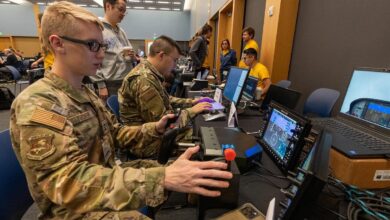The Unhackable Quantum Internet: Future of Cybersecurity

In the rapidly evolving world of internet technology, a groundbreaking development in quantum computing is setting the stage for an unhackable future of digital communication. Scientists have pioneered the practical application of quantum entanglement, a phenomenon where quantum particles become intertwined, allowing the transmission of information with unparalleled security. This breakthrough promises to create an internet that is not only safe from existing cyber threats but impervious to espionage, heralding a new era of cyber resilience.
Quantum Entanglement: Cybersecurity’s Next Frontier
The traditional defense mechanisms of cyber domains are regularly undermined by sophisticated hacks, but the quantum leap in secure communications offered by entanglement could change the game entirely. Financial, governmental, and defense sectors, where the security of information can be a matter of national interest, are set to benefit profoundly from quantum entanglement in their cybersecurity protocols.
Obstacles and Opportunities in Quantum Advancements
While the horizon is bright for quantum technologies, the path to implementation is strewn with challenges. Maintaining quantum coherence over long distances and harmonizing these innovations with established digital infrastructure requires ongoing research and development, as well as substantial investment. Skepticism and lack of public understanding also pose significant barriers to the adoption of quantum-integrated systems.
Buoyed by strong market forecasts and burgeoning investment from leading tech companies, the industry marches forward. Quantum key distribution, a method of secure communication using quantum entanglement, is making headway, presenting encryption that is not just complicated but, in theory, unbreakable—even by quantum computers.
Crossing the Quantum Divide
As research institutes and private companies invest heavily in quantum computing, the world takes a step closer to an internet founded on physics rather than fallible codes. Educational initiatives must ramp up to uplift public comprehension and mitigate concerns over these emerging technologies. In the meantime, publications such as IBM and Nature play a pivotal role in unpacking quantum innovations, offering a glimpse into a future where digital fortresses are built not of bricks but of entangled particles, indestructible in their design.
Quantum Entanglement: Cybersecurity’s Next Frontier
In the current landscape of cybersecurity, the integration of quantum physics, particularly quantum entanglement, is revolutionizing the way we think about protecting data. Quantum entanglement involves linking two particles in such a way that the state of one instantly influences the other, no matter the distance between them. This principle is key to developing a new breed of cyber defense, featuring encryption that leverages these entangled particles to transmit information with virtually unbreakable security.
Obstacles and Opportunities in Quantum Advancements
The industry’s advancement in quantum technologies is encountering several hurdles. Quantum states are delicate and can be easily disrupted by their environment, a phenomenon known as “quantum decoherence.” To realize practical applications, scientists must figure out how to preserve entanglement over the large distances typical of global communications networks. This issue necessitates sophisticated technology and considerable funding to address. At the same time, the newness and complexity of quantum computing can make it difficult for the public and even industry professionals to fully grasp, posing additional challenges to its widespread adoption.
Despite these challenges, the quantum computing market is experiencing rapid growth, with optimistic projections for the future. According to industry analysts, the global quantum computing market is expected to expand significantly in the coming years, as applications beyond cybersecurity, including drug discovery, material science, and financial modeling, begin to emerge.
Start-ups, major corporations, and governments worldwide are increasing their stakes in quantum computing research and development. Quantum key distribution (QKD) is one area gaining traction, with various enterprises focusing on implementing this theoretically secure communication method across different sectors.
Crossing the Quantum Divide
As this revolutionary technology gains ground, education and awareness are critical. Technical training for professionals and simplified educational materials for the broader public are essential to bridge the knowledge gap. Institutions of higher learning, tech companies, and publishers are all integral in this educational push. For instance, IBM has been at the forefront with initiatives, such as the IBM Quantum Experience, allowing users to experiment with quantum computing via the cloud. The esteemed scientific journal Nature also frequently features articles that dissect quantum theories and their applicable technologies, contributing to broader public understanding.
These educational and developmental efforts prepare the world for an internet supported by the principles of quantum mechanics—a quantum internet—potentially impenetrable to the cyber threats we face today. The infinite scope of applications stemming from quantum computing stands to redefine not just cybersecurity but nearly every high-tech industry on the planet. With strong market forecasts, rising investment, and a growing focus on quantum literacy, the quantum computing sector is poised for a future as interconnected and revolutionary as the entangled particles at its heart.

Natalia Toczkowska is a notable figure in digital health technology, recognized for her contributions in advancing telemedicine and healthcare apps. Her work focuses on developing innovative solutions to improve patient care and accessibility through technology. Toczkowska’s research and development in creating user-friendly, secure digital platforms have been instrumental in enhancing the effectiveness of remote medical consultations and patient monitoring. Her dedication to integrating technology in healthcare has not only improved patient outcomes but also streamlined healthcare processes, making her a key influencer in the field of digital health innovation.



